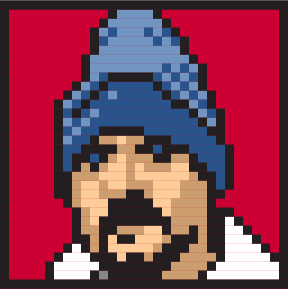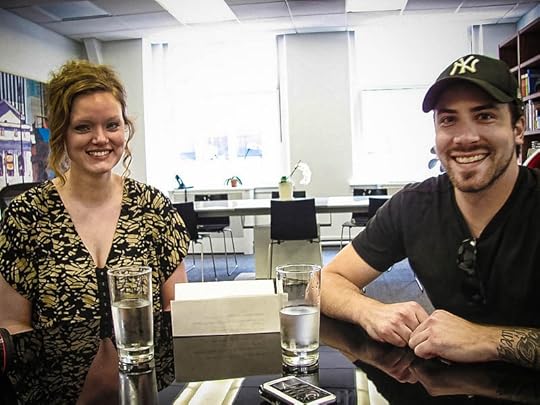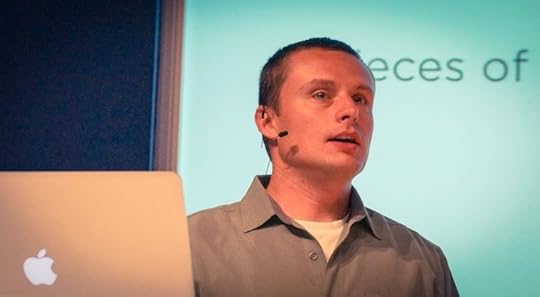Jeffrey Zeldman's Blog, page 44
June 23, 2013
Bootstrap creator Mark Otto: Big Web Show 93
MARK OTTO, creator of Bootstrap, is my guest on Episode No. 93 of The Big Web Show (“everything web that matters”).
Currently designing things at GitHub and previously at Twitter and ZURB, Mark may be found on the web at markdotto.com and on Twitter as @mdo.
URLS
http://markdotto.com
https://twitter.com/mdo
https://twitter.com/TwBootstrap
http://twitter.github.io/bootstrap/
https://github.com/mdo
June 17, 2013
Response to an anonymous note left on my apartment door, complaining of noise.

Dear Neighbors:
While my ex-wife is in treatment for a serious illness, I am watching her two small young dogs.
They get along well with my two cats and soothe my young daughter during her mother’s absence.
I am sorry that the dogs sometimes bark when I am at work. They are probably somewhat afraid.
The dogs will only be with us for a few more days. God willing, my ex will complete her in-patient treatment early next week.
I apologize for the noise during the day, and thank you for your patience and understanding.
Your Neighbor,
Jeffrey
May 30, 2013
Coastermatic’s Tash Wong and Tom Harman on The Big Web Show Episode No. 92
AMERICAN DESIGNER Tash Wong and British designer Tom Harman are the co-founders of Coastermatic and my guests in Episode No. 92 of The Big Web Show (“everything web that matters”).
Tash and Tom recently resided in Brooklyn, NY and completed their MFAs in Interaction Design at New York’s School of Visual Arts, where I was one of their admiring teachers; they are now bound for Hawaii, where they will expand their web-based product empire. Coastermatic, their first joint product, converts your Instagram photos into stone coasters, and was conceived during their time at SVA. (More in the August 2, 2012 issue of Dwell.)
In a fast-paced hour-long podcast, we discuss design, product, and business strategy; finding the right manufacturing and fulfillment partners; the division of labor in a small startup; and other juicy UX and entrepreneurial topics.
Enjoy Episode No. 92 of The Big Web Show.
May 23, 2013
10 Commandments of Web Design (Notes by Luke Wroblewski on a Talk by Yours Truly)
“ITERATION isn’t just for visual design. It also helps you uncover insights. A List Apart found people are often commenting and re-tweeting articles before they read them. They learned this by iterating on where the share and comment links exist on the page.”—LukeW | An Event Apart: 10 Commandments of Web Design.
May 19, 2013
Don’t Cry For Me, San Diego
May 10, 2013
Ryan and Tina Essmaker of The Great Discontent
RYAN AND TINA Essmaker are my guests for Episode No. 91 of The Big Web Show (“everything web that matters”).
Ryan is a designer and the co-founder of The Great Discontent. By day he works with Crush + Lovely as head of products, and manages No Little Plans, The Great Discontent’s parent company.
Tina is an illustrator, essayist, photographer, blogger, and the co-founder of The Great Discontent, an online journal of interviews focusing on creativity and risk, and No Little Plans, The Great Discontent’s parent company. By day she manages community for Crush + Lovely and works as a freelance writer.
This episode of The Big Web Show is sponsored by A List Apart, the design magazine for people who make websites.
Enjoy Episode No. 91 of The Big Web Show.
May 8, 2013
Adobe Love

I CAME to AdobeMAX in Los Angeles to give a talk to a room full of designers. Before arriving, I thought of Adobe as a historically important 20th century company that was slowly leaking relevance—a company web designers in the era of responsive design have begun to think of with a combination of fondness and embarrassment, like a beloved but somewhat shameful old uncle.
I came to LA with those perceptions, but I leave with the impression of an exciting 21st century company in emergence.
Realistic products for a magical age
The products I saw were both amazing and realistic. It was amazing to see a responsive design prototyping application that works independently and inside Photoshop, created by passionate people who actually work in our field and who consulted with Ethan Marcotte, for Pete’s sake.
That was the amazing part, but the equally important realistic part was that nobody was pretending this tool would be used to deliver final code on your website. It was not a responsive Dreamweaver I saw, but a prototyping tool, to help designers figure out how their responsive design should work (and maybe show the prototype to a boss or client for approval). Just prototyping. Nobody pretending they had a product that would make the difficult craft of front-end design redundant. No such intention behind the product. A product for the real work-flow of 21st century design teams. No marketing puffery, no inflated claims to set designers’ teeth on edge.
We are now them
More than that. Every Adobe employee I saw seemed to be excited, happy, and on-board with the mission. I see that kind of energy at good startups and small studios. I never see it in big corporations. It sometimes seemed to me that Adobe hadn’t so much acquired Typekit as the reverse: that the people and thinking behind Typekit are now running Adobe (which is actually true), and that the mindset of some of the smartest consultants and designers in our industry is now driving a huge corporation.
I never expected to see that in my lifetime, and to me, it is even more impressive than the amazingness and realism of the new product line or the transformation of the company from a shrink-wrapped product manufacturer to an inventor of cloud-based services. I never expected to see people like us running companies like that.
It makes me feel good about the future, when so many other things conspire to make us feel the opposite.
May 3, 2013
The Big Web Show No. 90: Paul Ford on emulators, archives, and the web
THE AMAZING PAUL FORD is my guest in Episode No. 90 of The Big Web Show (“everything web that matters”). In a fast-moving hour, we discuss computer system emulators on the web, designing web archives, the value of context in software and literature, the new tribalism, the fallacy of history, buying records when you are 16, why getting to magic is more important than attaining perfection, the interconnectedness of software design and storytelling, how parenting twins facilitates A/B testing, and loads more. Give it a listen!
URLs, URLs, URLs
Ftrain.com
A Conversation with Paul Ford, the Now-Former Web Editor of Harper’s Magazine
Harper’s and the Harper’s Archive
Activate
Save Publishing (bookmarklet)
The Web is a Customer Service Medium
Medium of Choice
Paul Ford on Medium
About Paul
Paul is a freelance writer and computer programmer. He was an editor at Harper’s Magazine from 2005–2010, and brought Harper’s 159-year, 250,000-page archive to the web in 2007; the system now supports tens of thousands of registered subscribers. More recently he helped the media strategy firm Activate with the launch of Gourmet Live, a re-imagining of Gourmet Magazine for iPad, and co-founded Popsicle Weasel, a small company totally focused on microsites.
He has written for NPR, TheMorningNews.org, XML.com, and the National Information Standards Organization’s Information Standards Quarterly, and is the author of the novel Gary Benchley, Rock Star (Penguin/Plume). Paul programs in PHP, Java, and XSLT2.0, but lately is all about Python and Django. His writing has been anthologized in Best Software Writing I (2005) and Best Music Writing 2009. He enjoys both software and music.
He teaches Content Strategy at the School of Visual Arts in New York City. His personal website, started in 1997, is Ftrain.com. He lives in Brooklyn, New York with his wife Mo and the obligatory cats.
McGrane: Kill Your CMS
THE ERA of “desktop publishing” is over. Same goes for the era where we privilege the desktop web interface above all others. The tools we create to manage our content are vestiges of the desktop publishing revolution, where we tried to enable as much direct manipulation of content as possible. In a world where we have infinite possible outputs for our content, it’s time to move beyond tools that rely on visual styling to convey semantic meaning. If we want true separation of content from form, it has to start in the CMS.–Karen McGrane, WYSIWTF ∙ An A List Apart Column.
60 Minutes of Luke
IT’S ANOTHER Full-length Friday! In this 60-minute video caught live at AEA Boston, Luke Wroblewski (Mobile First) explores multi-device design from the top down (desktop to mobile) and bottom up (using mobile to expand what’s possible across all devices):
An Event Apart News: AEA Video: Luke Wroblewski (author, Mobile First) – Mobile To The Future.









